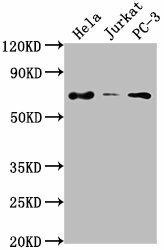PRICKLE3 Antibody (PACO61959)
- SKU:
- PACO61959
- Product Type:
- Antibody
- Reactivity:
- Human
- Host Species:
- Rabbit
- Isotype:
- IgG
- Applications:
- ELISA
- WB
- IHC
- Antibody Type:
- Polyclonal Antibody
- Conjugation:
- Unconjugated
Frequently bought together:
Description
| Antibody Name: | PRICKLE3 Antibody (PACO61959) |
| Antibody SKU: | PACO61959 |
| Size: | 50ul |
| Host Species: | Rabbit |
| Tested Applications: | ELISA, WB, IHC |
| Recommended Dilutions: | ELISA:1:2000-1:10000, WB:1:1000-1:5000, IHC:1:20-1:200 |
| Species Reactivity: | Human |
| Immunogen: | Peptide sequence from Human Prickle-like protein 3 protein (9-24AA) |
| Form: | Liquid |
| Storage Buffer: | Preservative: 0.03% Proclin 300 Constituents: 50% Glycerol, 0.01M PBS, pH 7.4 |
| Purification Method: | Antigen Affinity Purified |
| Clonality: | Polyclonal |
| Isotype: | IgG |
| Conjugate: | Non-conjugated |
 | Western Blot. Positive WB detected in: Hela whole cell lysate, Jurkat whole cell lysate, PC-3 whole cell lysate. All lanes: PRICKLE3 antibody at 1:2000. Secondary. Goat polyclonal to rabbit IgG at 1/50000 dilution. Predicted band size: 69, 60 kDa. Observed band size: 69 kDa. |
 | IHC image of PACO61959 diluted at 1:100 and staining in paraffin-embedded human heart tissue performed on a Leica BondTM system. After dewaxing and hydration, antigen retrieval was mediated by high pressure in a citrate buffer (pH 6.0). Section was blocked with 10% normal goat serum 30min at RT. Then primary antibody (1% BSA) was incubated at 4°C overnight. The primary is detected by a biotinylated secondary antibody and visualized using an HRP conjugated SP system. |
| Background: | Involved in the planar cell polarity (PCP) pathway that is essential for the polarization of epithelial cells during morphogenetic processes, including gastrulation and neurulation (By similarity). PCP is maintained by two molecular modules, the global and the core modules, PRICKLE3 being part of the core module (By similarity). Distinct complexes of the core module segregate to opposite sides of the cell, where they interact with the opposite complex in the neighboring cell at or near the adherents junctions (By similarity). Involved in the organization of the basal body (By similarity). Involved in cilia growth and positioning (By similarity). |
| Synonyms: | Prickle planar cell polarity protein 3 (LIM domain only protein 6) (LMO-6) (Prickle-like protein 3) (Pk3) (Triple LIM domain protein 6), PRICKLE3, LMO6 |
| UniProt Protein Function: | LMO6: LIM domain only 6 is a three LIM domain-containing protein. The LIM domain is a cysteine-rich sequence motif that binds zinc atoms to form a specific protein-binding interface for protein-protein interactions. [provided by RefSeq, Jul 2008]Chromosomal Location of Human Ortholog: Xp11.23Molecular Function: protein binding |
| UniProt Protein Details: | |
| NCBI Summary: | LIM domain only 6 is a three LIM domain-containing protein. The LIM domain is a cysteine-rich sequence motif that binds zinc atoms to form a specific protein-binding interface for protein-protein interactions. [provided by RefSeq, Jul 2008] |
| UniProt Code: | O43900 |
| NCBI GenInfo Identifier: | 33876719 |
| NCBI Gene ID: | 4007 |
| NCBI Accession: | BC002468 |
| UniProt Secondary Accession: | O43900,O76007, Q53XR5, B7Z8F2 |
| UniProt Related Accession: | O43900 |
| Molecular Weight: | 59,097 Da |
| NCBI Full Name: | Homo sapiens prickle homolog 3 (Drosophila), mRNA |
| NCBI Synonym Full Names: | prickle planar cell polarity protein 3 |
| NCBI Official Symbol: | PRICKLE3 |
| NCBI Official Synonym Symbols: | LMO6 |
| NCBI Protein Information: | prickle-like protein 3 |
| UniProt Protein Name: | Prickle-like protein 3 |
| UniProt Synonym Protein Names: | LIM domain only protein 6; LMO-6; Triple LIM domain protein 6 |
| Protein Family: | Prickle-like protein |
| UniProt Gene Name: | PRICKLE3 |
| UniProt Entry Name: | PRIC3_HUMAN |
| Antibodies |
| PRICKLE3 Antibody (PACO11461) |
| Secondary Antibody |
| Anti-HRP Goat Anti-Rabbit IgG (H+L) Antibody (CABS014) |
| Recommended Products |
| Anti-FITC Goat Anti-Rabbit IgG (H+L) Antibody (CABS011) |
| Anti-HRP-conjugated Beta Actin Antibody (CABC028) |





